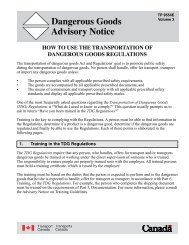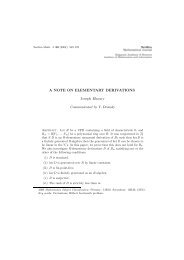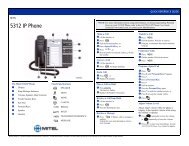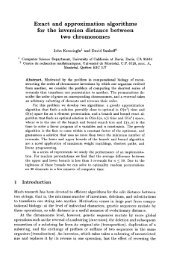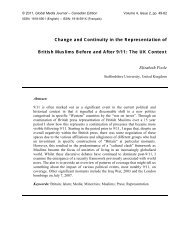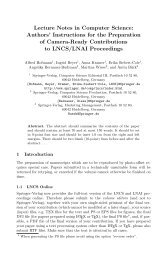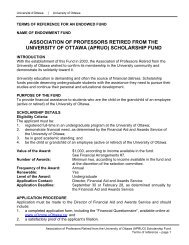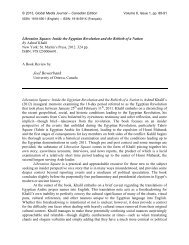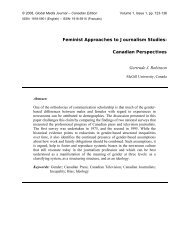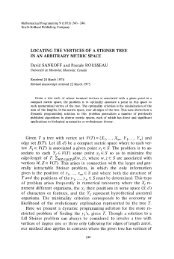PRACTICING PRECAUTION and ADAPTIVE MANAGEMENT ...
PRACTICING PRECAUTION and ADAPTIVE MANAGEMENT ...
PRACTICING PRECAUTION and ADAPTIVE MANAGEMENT ...
- No tags were found...
You also want an ePaper? Increase the reach of your titles
YUMPU automatically turns print PDFs into web optimized ePapers that Google loves.
It is important to note that the application of the TAC decision making process <strong>and</strong> theproduction of science-based SSRs for stocks also varies across regions of DFO. For example, thecontent of SSRs for cod stocks of Newfoundl<strong>and</strong> <strong>and</strong> Labrador versus cod stocks in the Gulf ofSt. Lawrence versus those in the Maritimes Region of DFO all vary <strong>and</strong> are not directlycomparable. Moreover, the interpretation of the management of these same species but differentstocks across regions, is quite different. For example, estimates of spawning stock biomass in theGulf of St. Lawrence at 80 thous<strong>and</strong> tonnes in 2003 led the Minister to closing this stock to allcommercial fishing whereas estimates of less than 30 thous<strong>and</strong> tonnes for 4X5Y cod (Fig 3)supported a commercial fishery with a TAC of 6,000t.While it is difficult to compare regional stocks directly, the evidence points to a need forscientists throughout the institution responsible for providing information <strong>and</strong> analysis on stockstatus to compare <strong>and</strong> contrast their interpretations <strong>and</strong> underst<strong>and</strong>ing of the data to lead toconsistent <strong>and</strong> precautionary results.III.E. Evidence of administrative conflictsThe process of TAC setting from the development of the science-based SSR to the consultation<strong>and</strong> holistic system approach of the FRCC recommendations is designed to avoid administrativeconflicts encountered in the pre-1992 period. This process was meant to be a model oftransparency <strong>and</strong> participation by all stakeholders following a period of reaction to a failedcontrol system that arguably did not provide opportunity for full analysis <strong>and</strong> consideration ofalternatives.After 1992, what changed was the DFO science stranglehold on the TAC advice to theMinister. While acknowledging the importance of science in the production of the SSRs, theopportunity to provide a critical review of the science contained in the SSR occurred through theFRCC. However, the FRCC remained a consultative body that provided recommendations.Accordingly, the Minister’s retention of the decision making authority effectively meant that hewas ultimately influenced in setting TACs by his internal science <strong>and</strong> management staffers, theFRCC recommendations, as well as the lobbying of the fishing industry, <strong>and</strong> environmentalNGOs. The Minister’s wide m<strong>and</strong>ate as sole authority under the law, <strong>and</strong> the lack of a clear“weighting” of the resource sustainability versus the social viability versus the administrativecost of management means that the range of feasible TACs for a given stock can be defended as“precautionary” in spite of the inherent conflicts.Evidence of these inherent conflicts is presented in the parallel cases of cod <strong>and</strong> haddockin 4X5Y described above. Arguably, the presentation of the optimistic growth of haddock isqualitatively precautionary leading to no increase in exploitation in 2002 <strong>and</strong> a relatively smallincrease in the 2003 TAC. If these same interpretations were applied to the cod stock, then onewould suspect that the SSR would not be inclined to defend the status quo exploitation rate <strong>and</strong>avoid all reference to the stock target objectives set by a previous Minister. When the FRCCattempted to act as the corporate memory for the 3-year plan, the Minister used his prerogative todecide on status quo despite evidence to the contrary.This does not imply that the Minister’s decision was not precautionary. Rather, it shouldbe understood that precaution with respect to other dimensions of the decision took precedenceover the resource sustainability dimension in this case. The fact that formal analyses for theseother dimensions are not specified does not reduce the need for there full consideration, but itdoes confound the clarity of the basis on which the Minister’s decisions are made.Dan E. Lane – Setting TACs in the 4X5Y Cod <strong>and</strong> Haddock Fisheries D-119



